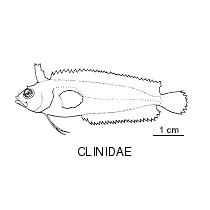- Classification
- ACTINOPTERYGII
- PERCIFORMES
- CLINIDAE
Family CLINIDAE
Mostly small well-camouflaged bottom-dwelling fishes with reduced finger-like pelvic fins located under the rear of the head, the dorsal fin with a long-based spinous portion joined to a short soft-rayed portion, and the head often adorned with orbital and nasal tentacles. Weedfishes have internal fertilization and many species give birth to live young.
More Info
|
Family Taxonomy |
Currently, 84 described species in 25 genera are known worldwide. In Australian waters, 7 genera with 32 described species are recognised, and another 9-10 species are yet to be described. The Australian clinids are currently being studied by Doug Hoese and Stephanie Chapple. |
|
Family Distribution |
Marine fishes mostly found in temperate waters of Australia, New Zealand, South Africa, North and South Atlantic and the Mediterranean. Most species in Australia live in southern waters, where they are commonly found in seagrass beds and around macroalgae on rocky reefs. Although most live in shallow coastal waters above 50 metres, some species of Cristiceps are found to depths greater than 100 m. |
|
Family Description |
Mostly small well-camouflaged cryptic fishes with reduced finger-like pelvic fins with one spine and 2-3 rays located under the rear of the head, and a dorsal fin with a long-based spinous portion joined to a short soft-rayed portion. The spinous part is often subdivided and begins with several stiff spines, and the soft-rayed part contains up to 6 rays. The head is often adorned with orbital and nasal tentacles. |
|
Family Size |
Maximum size is 60 cm (40 cm for Australian species). |
|
Family Colour |
Extremely well-camouflaged cryptic fishes, with colour patterns to match the surrounding algae and seagrasses. |
|
Family Feeding |
Voracious carnivores. |
|
Family Reproduction |
Weedfishes have internal fertilization and many species give birth to live young. Australian weedfishes are ovoviviparous, generally with multiple batches of eggs and/or embryos in a single female (Gunn & Thresher 1991). Males have a simple, conical intromittent organ. |
|
Family Commercial |
Of no interest to fisheries. |
|
Family Conservation |
|
|
Author |
Dianne J. Bray & Douglass F. Hoese |
References
George, A. & Springer, V.G. 1980. Revision of the clinid fish tribe Ophiclinini, including five new species, and definition of the family Clinidae. Smithsonian Contributions to Zoology 307: 1-31. PDF Open Access
Gunn, J.S. & Thresher, R.E. 1991. Viviparity and the reproductive ecology of clinid fishes (Clinidae) from temperate Australian waters. Environmental Biology of Fishes 31: 323-344.
Hoese, D.F. 2006. Clinidae. In: Beesley, P.L. & Wells, A. (eds) 2006. Zoological Catalogue of Australia. Volume 35 Australia : ABRS & CSIRO Publishing Parts 1-3 2178 pp.
Hoese, D.F., M.F. Gomon & D.S. Rennis. 2008. Family Clinidae (pp. 696-722). In: Gomon. M.F., Bray, D.J. & Kuiter, R.H (eds). Fishes of Australia's Southern Coast. Sydney : Reed New Holland 928 pp.
Hoese, D.F. & D.S. Rennis. 2006. Description of a new species of Heteroclinus (Blennoidei: Clinidae) from Southern Autralia. Mem. Mus. Victoria 63(1): 21-24.
Kuiter, R.H. 1993. Coastal Fishes of South-eastern Australia. Bathurst : Crawford House Press 437 pp.
Rennis, D., Hoese, D.F. & Gomon, M.F. 1994. Family Clinidae. pp. 741-775, figs 650-684B in Gomon, M.F., Glover, C.J.M. & Kuiter, R.H (eds). The Fishes of Australia's South Coast. Adelaide : State Printer 992 pp. 810 figs.
Springer, V.G. 1993. Definition of the suborder Blennioidei and its included families (Pisces: Perciformes). Bulletin of Marine Science 52(2): 472-495.
Stepien, C.A. 1992. Evolution and biogeography of the Clinidae (Teleostei: Blennioidei). Copeia 1992(2): 375-392






























































































































































































































